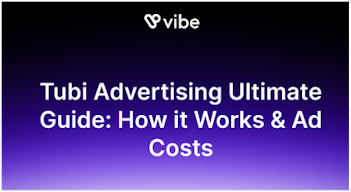CTV Ad Measurement: 7 Key Metrics To Check Its Effectiveness
Ready to supercharge your Connected TV (CTV) advertising?
You'll find valuable insights to elevate your campaigns to the next level.
Here’s what we’ll cover in this blog:
- 7 key metrics that are essential for CTV measurement and ad performance.
- Real-world examples to show how these metrics can guide smarter strategies and better ad spending.
- Actionable insights to track and improve your campaigns, ensuring they hit the mark with your audience.
Let’s break down these metrics so you can optimize your CTV campaigns and maximize your ROI.
But first, let’s understand CTV measurement.
What is CTV Measurement?
Connected TV (CTV) measurement is an essential aspect of modern advertising. It enables marketers to track and analyze the effectiveness of their campaigns in real-time.
Understanding how CTV measurement works can significantly improve your advertising strategy and drive better results.
How Does It Work?
- Ad Delivery & Data Collection: When ads are served on CTV platforms, vital metrics such as impressions and completion rates are collected. This initial data is essential for gauging how well your ads are performing.
- Data Integration: The data is then integrated from various sources, allowing for a complete analysis of campaign performance. This aggregation helps you understand the broader impact of your advertising efforts.
- Real-Time Analysis: Analytics platforms provide immediate insights into campaign performance, allowing you to make necessary adjustments in real-time.
- Audience Segmentation: You can utilize the viewer data to create targeted audience groups based on demographics and behaviors.
- Performance Reporting & Optimization: Detailed reports outline ad effectiveness, enabling marketers to refine future campaigns based on real-time feedback.
This continuous loop of measurement and adjustment is vital for maximizing ROI. Now, let’s move on to the 7 key metrics for CTV measurement.
- Impressions
Impressions measure how many times your ad appears on viewers' screens. This metric is essential for understanding your campaign's overall reach and visibility.
Key Tactics:
- You need to monitor impressions regularly to gauge how visible your ads are.
- You can adjust targeting or budget based on impression data to ensure optimal exposure.
Example: A streaming service monitors impressions closely to ensure its ads are frequently displayed during popular shows, maximizing their reach among engaged viewers.
- Conversion Rate
The conversion rate indicates the percentage of viewers who take a desired action after seeing your ad, such as visiting a website or purchasing.
Key Tactics:
- You need to analyze which ads drive conversions to identify successful strategies.
- Also, refine creative elements based on conversion data.
Example: An e-commerce brand sees increased sales after airing targeted ads during major events, demonstrating the power of timing and relevance in driving conversions.
- Cost Per Mille (CPM)
CPM represents the cost of serving 1,000 impressions on a CTV platform.
Key Tactics:
- You should compare CPM across platforms to identify the most cost-effective options.
- You can use CPM data for effective budgeting, ensuring you get the best return on your investment.
Example: A tech company evaluates CPM rates to pinpoint the most economical ad placements, allowing them to stretch their advertising budget further.
- Cost Per Acquisition (CPA)
CPA measures the cost required to generate a specific action through your CTV campaign, linking advertising expenses directly to business outcomes.
Key Tactics:
- You must track CPA to evaluate campaign profitability, ensuring your spending aligns with desired results.
- You should optimize for lower CPA strategies, focusing on approaches that yield high returns at minimal costs.
Example: A subscription service analyzes CPA to determine which ads yield the highest sign-ups at the lowest cost, enabling smarter spending decisions.
- Viewability Rate
The viewability rate measures the percentage of ad impressions that were viewable by the audience. This metric ensures that your ads have a chance to make an impact.
Key Tactics:
- You must monitor viewability rates for effective ad placement, ensuring potential customers see your ads.
- Remember to focus on improving viewability, as higher rates often lead to better engagement outcomes.
Example: A beverage brand adjusts its ad placements after discovering low viewability rates during specific time slots, optimizing its strategy for better visibility.
- Completion Rate
The completion rate tracks how many viewers watch your ad from start to finish, indicating audience engagement.
Key Tactics:
- You should analyze completion rates to refine content, identifying what resonates with viewers.
- Remember to create compelling narratives that encourage full views, enhancing overall engagement.
Example: A travel company finds that visually appealing ads have higher completion rates, prompting them to focus more on visual storytelling in their campaigns.
- Audience Reach
Audience reach represents the total number of unique viewers exposed to your ad over a specific period. This metric provides insight into campaign scope and effectiveness.
Key Tactics:
- You need to evaluate audience reach for market penetration, understanding how widely your message is distributed.
- Also, strategies should be adjusted based on reach data, aiming for broader connections with potential customers.
Example: A fashion retailer assesses audience reach during significant events like award shows to maximize visibility among potential customers, ensuring their brand is front and center when it matters most.
Focusing on these seven key metrics can help you gain valuable insights into your CTV advertising campaigns. Each metric is vital in shaping your strategy and improving overall performance.
What Challenges Stand in the Way of Ad Measurement Across Linear and CTV?
Let's learn the obstacles you may face during Ad measurement.
Key Challenges in Ad Measurement
- Lack of Standardization: Inconsistent measurement practices complicate your evaluation of ad performance, as varying tools can yield different results.
- Attribution Complexity: Figuring out which ads drive viewer actions across platforms can be challenging. Multi-touch attribution adds another layer of complexity for you.
- Real-Time Measurement Gaps: Linear TV often relies on delayed reporting, while CTV offers real-time insights, complicating your campaign optimization efforts.
- Audience Fragmentation: With viewers spread across multiple platforms, tracking reach and engagement becomes difficult. You’ll need advanced targeting strategies to connect effectively.
- Privacy Regulations: Stricter privacy laws may limit your data collection, impacting your ability to track user behavior and measure campaign success.
Optimizing CTV campaigns isn’t just about metrics—it’s also about having the right tools to streamline your efforts.
The right tools simplify tracking, analysis, and decision-making, but with so many options available, it's important to choose the ones that deliver real value.
As you navigate this landscape, consider how the right platform can enhance your advertising strategy. Vibe stands out in this regard.
Vibe is designed to provide actionable insights, enabling you to maximize your ad performance.
Let’s explore how Vibe can transform your campaigns and help you achieve your goals.
Optimizing Your CTV Measurement with Vibe
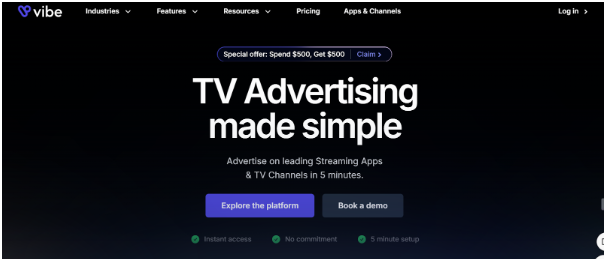
Vibe allows you to set up and run TV advertising campaigns across 500+ channels within minutes.
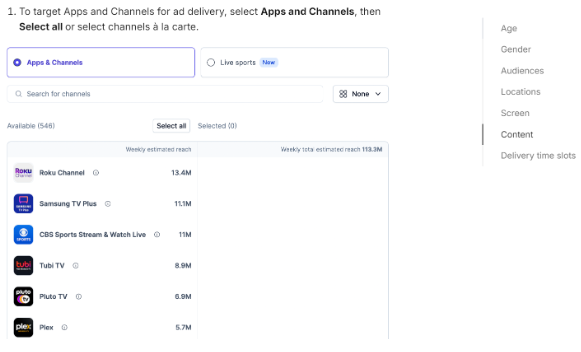
Here’s why Vibe stands out:
- Vibe automates ad placements across various streaming channels, including sports, movies, and local news, ensuring your ads reach diverse audiences.
- With Vibe, you can analyze real-time data to ensure your ads are delivered to the right audience at the right time.
- Brands can target audiences based on location, demographics, interests, or purchase intent, improving engagement.
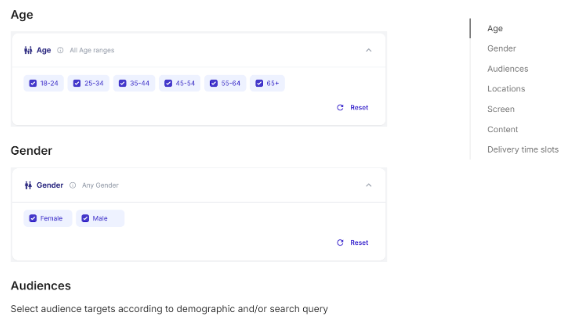
- Vibe offers competitive pricing starting at just $500, with CPM rates between $15 and $35.

- You can track campaign success through real-time insights on conversions, impressions, and audience engagement.
- The Vibe AI Assistant recommends optimal channels and targeting strategies tailored to your campaign goals.
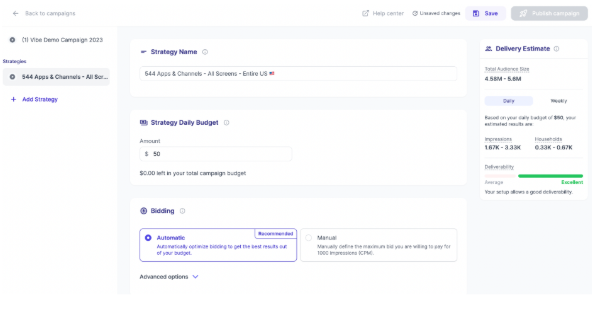
- Vibe Studio allows users to produce high-quality TV ads quickly, even without prior experience.
By integrating Vibe into your TV marketing strategies, you can tackle common challenges in ad measurement and create impactful campaigns that resonate with your target audience.
Conclusion
Now that we’ve explored the key metrics for measuring Connected TV (CTV), let’s recap the essential points.
Understanding metrics such as impressions, conversion rate, CPM, CPA, viewability rate, completion rate, and audience reach is essential for optimizing your advertising efforts.
While there are challenges, focusing on these metrics and leveraging the right tools can elevate your campaigns and achieve better results.
To further improve your campaign's effectiveness, consider utilizing our platform – Vibe.
Vibe offers advanced targeting capabilities and creative tools designed to maximize the impact of your TV ads. It can automate ad placements and help you to navigate the complexities of CTV advertising.
Using the right platform and strategies, you can elevate your TV marketing efforts by cultivating genuine engagement with your audience.


